A walk around Notting Hill and Portobello Market
urban75 walk club, May 2004
Words and photos © Mike Slocombe, 2005
Notting Hill Gate was on the main London to Silchester Roman road, and there's evidence of Saxon occupation around AD 700, with the 'sons of Cynesige' founding Cheniston (Kensington) and the 'sons of Cnotta' or Cnotingas moving further up the hill.
Despite some fanciful Victorian tosh associating the name with nut trees, this is the true derivation of Notting Hill.
Although the place is now a bustling urban area, in the mid 18th century it was a country hamlet, known for its gravel pits and roadside inns, which proved a magnet for dastardly highwaymen.
The unpopular tollgate which gave the road its name appeared in the 18th century, and by 1840 the hamlet had grown into a village.
Industrialisation brought workers in from the countryside, with landlords building tiny terraced houses to rent to the poor.
In Victorian times, Notting Hill was a rough working class area and by the 1950s the area had become synonymous with slum landlords and inner city deprivation.
In 1958, it was the scene of race riots after problematic relations between the newly arrived black community and continuing harassment from the Teddy Boys of the fascist British Union.
A second riot during the famous Notting Hill Carnival of 1976, inspiring the Clash's punk anthem, 'White Riot'.
The past 30 years have seen a steady northwards swarm of gentrification, with estate agents coining names like 'Hillgate village' for previously working class neighbourhoods, sending property prices rocketing.
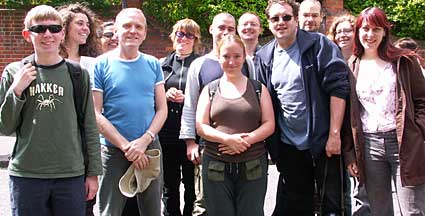
urban75 walk club assemble
On a glorious May afternoon, the walkers meet up at outside Notting Hill Gate tube station.
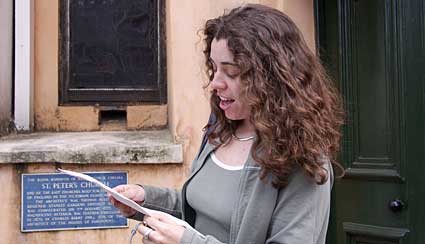
Our guide in action!
Any regular on the urban75 bulletin boards can take their turn to suggest a monthly walk, but the onus is on the guide to keep us entertained and informed with an onslaught of facts! facts! facts!
Our charming guide did not disappoint (well, at least for the first half of the walk!)

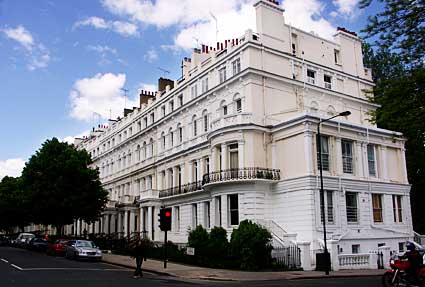
Apartment block, Notting Hill Gate
Notting Hill was not all shoddy flats and dodgy landlords, and there's some mighty fine Georgian, Edwardian and Victorian architecture to be seen.
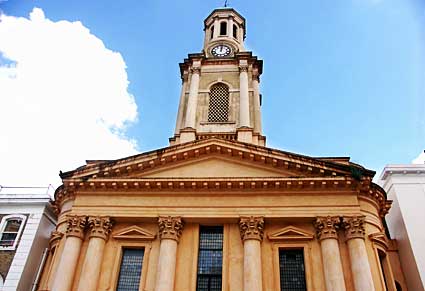
St Peter's church, Kensington Park
St Peter's was designed by Thomas Allom in 1855, along with the surrounding housing in Kensington Park Gardens, Stanley Crescent and Stanley Gardens.
The church was consecrated on 7 January 1857 by the Bishop of London, Archibald Campbell Tait, who went on to become the Archbishop of Canterbury in 1869.
At the time of opening, the church could pack in 1,400 worshippers and is probably the last 19th century Church of England church to be built in the classical style in London.
The church is noted as a building of exceptional architectural quality, and is listed Grade II*.

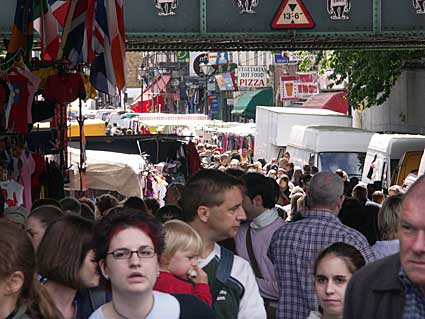
Portobello Street market,
Portobello Road was once a quiet country track, and can be seen in an 1841 map of the areas as 'Porto Bello Lane', which connected Kensington Gravel Pits (now Notting Hill Gate) with Kensal Green.
Portobello Road was named after Puerto Bello, a port in the Gulf of Mexico which exported treasure to Spain and imported European goods into Central America.
Admiral Sir Edward Vernon, with a small fleet of British navy ships, captured the port in the battle of 1739 and to commemorate the event, pubs, streets and districts all over the Empire were named after Vernon and Portobello.
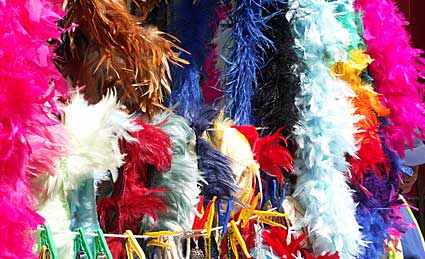
Feather boas, Portobello market
Portobello Road developed between the estates of Notting Hill and Paddington during the late nineteenth century, with its shops and markets serving the large houses on the estates.
Later development to the north created a market for goods and services for working class people in the surrounding terraces.
In 1836, John Whyte leased 2000 acres on the crown of Notting Hill to create 'a racing emporium more extensive than Ascot or Epsom', but his plan rapidly back-fired with waterlogged courses making it impossible for the horses to run.
His course also blocked a right-of-way to Notting Barn Farm, seriously miffing locals who promptly destroyed his fences at the first opportunity.
By 1842 Whyte had given up, and the racecourse was sold to be developed into crescents and terraces.
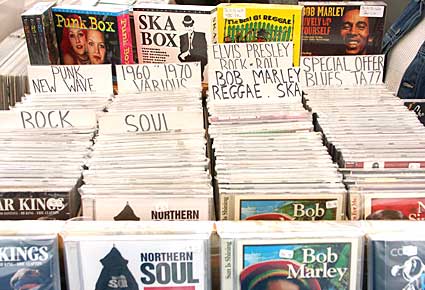
Old records for sale, Portobello Street market
The Market (known locally as `the lane') begun in the late 1860's or early 1870's and was one of several street Markets operating at the turn of the century.
Originally being held on Saturdays, trading hours were extended from Monday to Saturday in 1927, despite vehement protests from local shopkeepers.
Today, the market serves up three experiences - antiques and bric-a-brac to the south, fruit and vegetables in the middle, with second-hand clothing, bedding and bits'n'bobs to the north.
Portobello offers an unusually wide range of small, independent shops with a fine selection of ethnic food shops serving the diverse local community.


Makeshift second hand book stall.
Some of the stalls and displays are a bit more temporary than others!
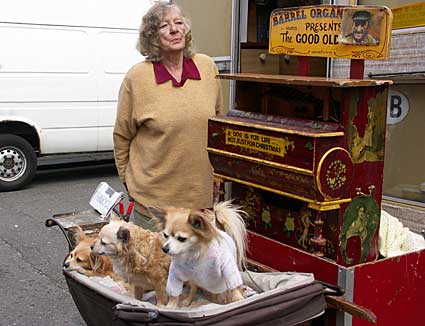
Barrel Organ and dogs
There's always something interesting going on along Portobello's bustling market, including this bizarre scene of dogs in a pram listening to a barrel organ.
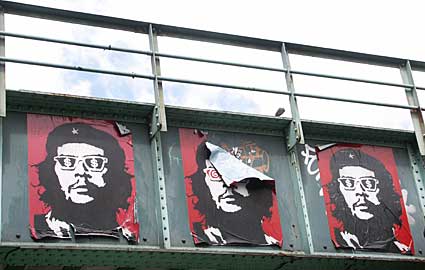
Posters over Portobello

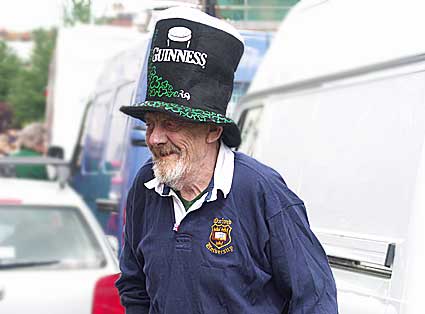
The slowest busker in the world
Ths guy was tap-dancing at such an incredibly slow rate we weren't sure if he was about to nod off to sleep.
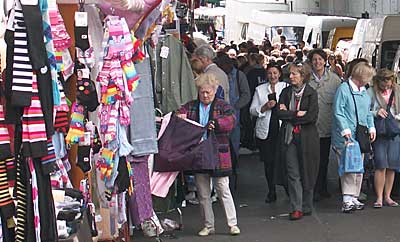
Shopping for clothes
The market is famous for its clothes stalls, offering cheap new clothes, second hand clobber and designer outfits.
It was at this point that we realised the walk leader had cunningly lead us to a stall where she wanted to buy a new dress from, and that was about as far as the walk was going to go!
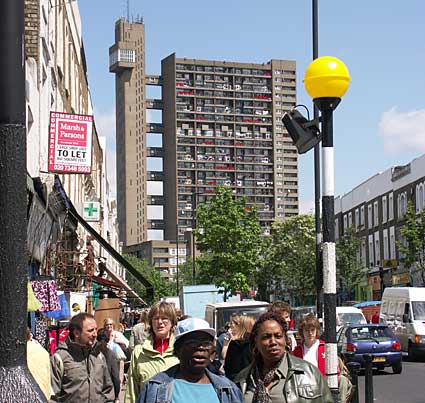
Trellick Tower
A quick flick through the A-Z later and we were on our way to a picnic sight by the Grand Union.
On the way we passed the 31 storey, 322 feet high rectangular slab known as Trellick Tower.
Built by Hungarian émigré, Erno Goldfinger, in 1972, for many years the tower epitomised everything that was wrong with modernist high-rise buildings.
Stories abounded of women being raped in elevators, children attacked by heroin addicts and squatters setting fire to flats,but since the installation of a concierge and extra security, the Tower's reputation has been transformed.
Trellick Tower is now something of a style icon, being granted a Grade 2* listing in 1998.

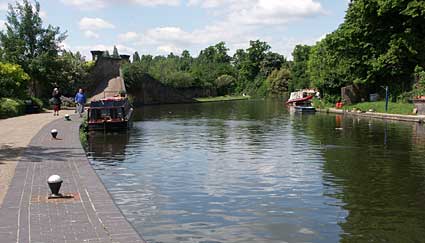
Grand Union canal, by Ladbroke Grove
With a lavish ceremony at Paddington Basin the Grand Union canal was opened in 1801. The celebration featured the ringing of bells and volleys of canon fire, and was attended by 20,000 people.
Nationalised in 1948, the Grand Union route was one of the last in Britain to keep commercial traffic alive, although it was in terminal decline by the 1950s due to increased road trasnport.
Now well used by leisure craft, it's a great place to walk or picnic.
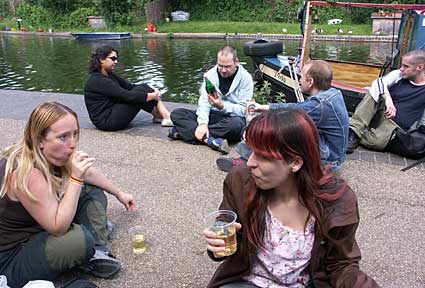
Picnic, Grand Union canal
Armed with lashings of beer, wine, cheese and bread, the urban75 walk crew relax by the canal.
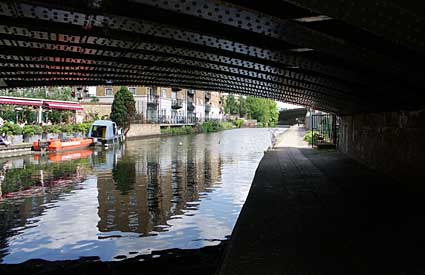
Walking the Grand Union canal
With the need to visit a pub reaching critical, we headed off east along the towpath.
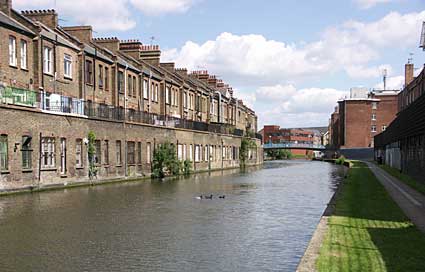
Houses on the Grand Union canal
The canal runs parallel with the Harrow Road, and the backs of its houses are perched perilously close to canal.
Looming ahead is the footbridge that was to take us to a pub!
|

